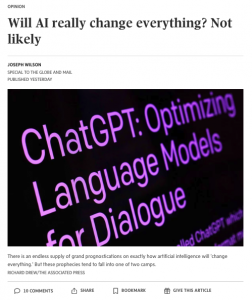Will AI really ‘change everything’?
I wrote what I thought was a useful corrective to never-ending deluge of AI hype (originally I wrote “bullshit” but they didn’t want to print that in the Globe for some reason). The vast majority of the apps built on top of GPTx and other LLMs have one purpose: to create marketing copy/emails/product reviews/blogs… also known as spam.
Read the full article here.
I also spoke on Edmonton’s CHED with Chelsea Bird about hype and how people can be more critical of the claims of Big Tech regarding AI’s super-human powers.

Technolinguistics in Practice: Socially Situating Language in AI Systems
Looking forward to joining other social scientists and linguists at the University of Siegen in May to present:
“What Python Can’t Do: Language Ideologies in Programming Courses for Natural Language Processing”
[snip]:
Many of the applications that are used in machine learning and natural language processing (NLP) are written in a computer language called Python. Python has become one of the fastest growing programming languages and knowledge of it can be considered a valuable form of social capital (Bourdieu 1977). The structure of Python, explicitly introduced as a language itself, reinforces a language ideology that sees language as a semantic, referential, and universal system (Jablonski n.d.; Lovrenčic et al. 2009; Danova 2017). This contrasts with the position taken by most linguistic anthropologists that sees language as primarily pragmatic, indexical, and highly localized in its ability to convey meaning (Silverstein 1976; 1979; Gal and Irvine 2019; Nakassis 2018; Eckert 2008). “
Images created by ChatGPT and Dall-E
The Teenage Gaze
This is a quick PechaKucha I put together for the EASA’s Why the World Needs Anthropologists conference in Berlin in September.
I seek to answer the question ‘why does every generation of adults think their teenagers are the worst?’ Spoiler alert: it’s a process of semiotic drift.
Why AI Will Never Fully Capture Human Language
My latest for Sapiens.org:
“…from the perspective of linguistic anthropology, novel-writing cars and chatbots designed for “natural language processing” simply do not command language at all. Instead, they perform a small subset of language competency—a fact that is often forgotten when the technology media focuses on sensational claims of AI sentience. Language, as it lives and breathes, is far more complicated.”
Read the full article here.

In practice, language is often far more complicated and layered than the written word can capture.
COVID shows why we need the social sciences now more than ever
Understanding why some reject discovery and innovation is essential to us all. Pure emphasis on ‘STEM’ without wider cultural study leaves society prey to conspiracy theories.
Read the full article in the Ottawa Citizen here.

A nurse prepares a booster dose of the Moderna COVID-19 vaccine. If we focus only on science, and not also on the cultural context in which people act, we will be baffled to find that many turn their backs on the modern discoveries and innovations that can help us all. PHOTO BY MICHELE TANTUSSI /REUTERS


